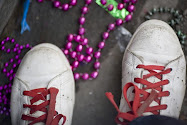 The base is small. Everyone has gotten used to seeing a couple of reporters (Phin and myself) walking around and most are happy to talk to us, including the head of the cafeteria (a KBR employee) who let us know he could be fired if seen talking to us. This morning we just wanted breakfast, no interviews, but let him speak his mind all the same. Having a press badge must be similar to what it is like to be a priest sitting in a confessional.
The base is small. Everyone has gotten used to seeing a couple of reporters (Phin and myself) walking around and most are happy to talk to us, including the head of the cafeteria (a KBR employee) who let us know he could be fired if seen talking to us. This morning we just wanted breakfast, no interviews, but let him speak his mind all the same. Having a press badge must be similar to what it is like to be a priest sitting in a confessional.On our first mission out, we returned to an Iraqi police station made up of three stations in one, know as the Tri Station. On the way there we stopped at a police checkpoint and checked out the sheep in the meat market across the street that get slaughtered on site when purchased. After the station visit we went on a foot patrol along what is know as the Golden Wall- a barrier made up T-walls encircling the southern part of Sadr City. It was put up a year ago to stop the flow of insurgents and weapons. The walled off part of Sadr City is home to some members of JAM (Jaysh al-Mahdi Militia) and Al Qaeda. The MP’s and most IP’s don’t venture inside, keeping their patrols to the perimeter only.
In the station, we went to check on three new prisoners from Iran who were drawing a lot of interest from different parties including internal affairs officers and fashionably dressed humanitarian representatives. Some of the prisoners put on a show for our cameras, making animal noises and laughing with the National Guard while the Iranian prisons biometric information was taken. The situation was bordering mayhem as prisoners were taken out one by one to visit a doctor in a tight corridor. The IP’s opened one cell door long enough for me to take a few pictures after warning me the prisoners were dangerous. The cells are overcrowed. Many of the prisons have yet to be charged despite being incarcerated for lengthy periods of time. The Iraqi justice system like the police system is in early stages of being revamped by Americans hired to mentor and advise them, helping the Iraqis to transform their justice system to emanate a western one. Lt. Owsley told me the MPs have advised the Iraqis to address the overcrowding situation before the Red Cross comes and closes the place down. Prisons all over the country are overcrowded. Bucca, an American-run prison in southern Iraq, is in the process of being closed despite fact many inmates are still thought to be insurgents. The Iraqi courts lack evidence to prosecute them so many are being set free.
From the station we went to a checkpoint at the Golden Wall. The MP’s met up with a group of IP’s, to train them to conduct community oriented policing practices. This entails walking around the neighborhood showing their presence while at the same time being friendly, letting the citizens get used to having IPs on the job since policing has been done by the IA (Iraqi Army) up until now. The police are not trusted and it is part of the MP s mission to help the IP build trust with the people. The IPs were a little awkward at first, but became more gregarious as we walked along the wall, saying hello and shaking hands with all the shop owners along the way.
The wall’s security value seems to have paid off. JAM stopped shelling the Green Zone shortly after the wall went up and more businesses have reopened. The wall also is a giant canvas. It is covered with murals as far as the eye can see that were financed with $100,000 from MNFI (Multi National Forces Iraq) — the US lead coalition.













 My favorite part of the complex is Flintstone Village, which is across the lake from the Victory Over America Palace. Saddam Hussein was a big fan of the Flintstones and had the complex modeled after the Hanna-Barbera cartoon, for his grandchildren to play in equipped with miniature golf coarse and elevators. Saddam commissioned the life-sized playground was after having his daughter’s husbands killed.. The sons in law, made the mistake of criticizing his regime and then returning to Baghdad after being in exile, accepting an invite from Saddam who asurred them all was forgiven. Flintstone Village was meant to be a gift meant to take thier minds off thier murdered fathers
My favorite part of the complex is Flintstone Village, which is across the lake from the Victory Over America Palace. Saddam Hussein was a big fan of the Flintstones and had the complex modeled after the Hanna-Barbera cartoon, for his grandchildren to play in equipped with miniature golf coarse and elevators. Saddam commissioned the life-sized playground was after having his daughter’s husbands killed.. The sons in law, made the mistake of criticizing his regime and then returning to Baghdad after being in exile, accepting an invite from Saddam who asurred them all was forgiven. Flintstone Village was meant to be a gift meant to take thier minds off thier murdered fathers






























